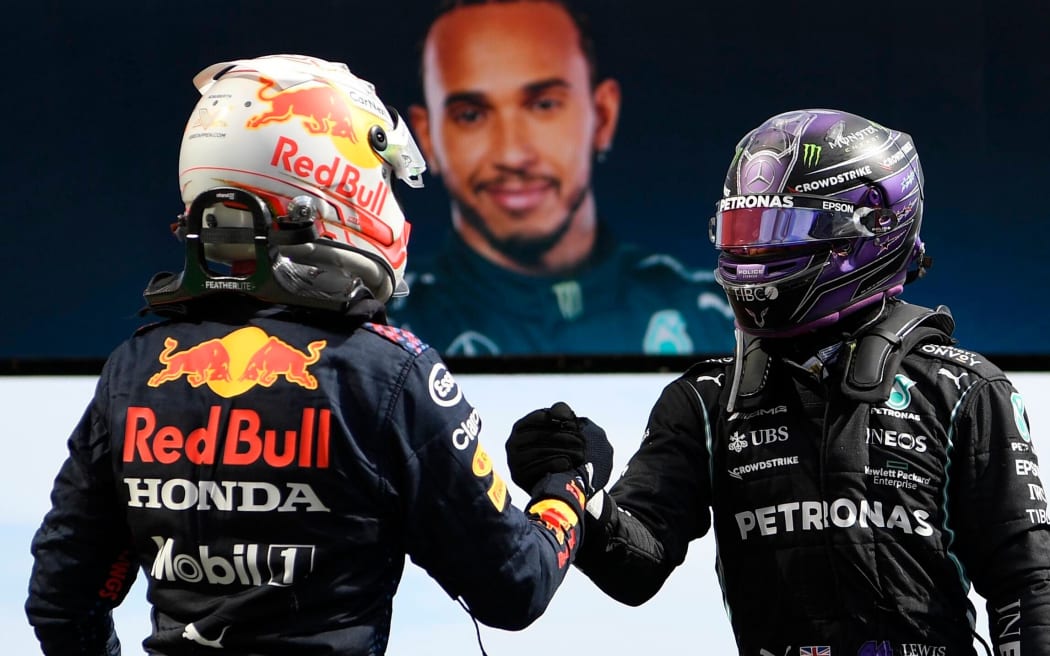
The 2021 Formula 1 title fight between Red Bull's Max Verstappen and Mercedes' Lewis Hamilton went right down to the last race. Photo: PHOTOSPORT
The Netflix series Drive to Survive has been a smash hit for Formula 1, but can motorsport here in New Zealand cash in on some of that success?
The fourth season of Drive to Survive was released on Netflix earlier this month, just in time for the start of the 2022 Formula 1 world championship. Each season of the documentary-come-reality TV series follows a year of the championship battle, but crucially, it's about more than just racing. Viewers get to go behind the scenes and learn about the drivers and their backstories, the rivalries and controversies, and of course the team politics. It's binge-worthy viewing and it's won F1 millions of new fans - but how?
Hold up, what is Formula 1?
Formula 1 (F1) is widely considered to be the pinnacle of motorsport. Names like Lewis Hamilton, Michael Schumacher and Ayrton Senna are synonymous with F1 - they're some of the best racing drivers the world has ever seen. The first F1 world champion was crowned back in 1950 (you can watch F1 driver Sebastian Vettel name every single world champion here), but obviously since then there have been huge advances when it comes to engineering, technology and safety.
In its current iteration, F1 involves 20 drivers from 10 teams competing at race tracks all over the world, from Monaco and Melbourne, to Singapore and Sao Paulo. This year, there'll be 23 races over the course of the season. The drivers compete for the prestigious individual driver's championship, while the teams jostle for the ultimately much more important constructor's title. The teams have to build the cars in accordance with very specific regulations and within budget caps. On track, it's pretty hair-raising stuff - the cars reach speeds well in excess of 300km/h and the drivers can pull something like 5G on some corners. There are plenty of good explainers online about how it all works, including this one.
How did Netflix end up with a show about Formula 1?
By the mid-2010s, F1 was facing a crisis, with declining crowd numbers, falling TV viewership and an ageing fan base. For decades, F1 had been run by Bernie Eccelstone, but it 2017 it was bought by American giant Liberty Media for US$4.4 billion. YouTuber and long-time F1 fan Josh Revell says there was was some initial skepticism about the move, with fears the sport would be 'Americanised'. But what's clear now is the ownership change has completely revolutionised and revitalised F1.
Some of the changes have been more subtle, like a new theme song, and there have also been changes to how race weekends work. But it's the big push into digital and social media, and the deal with Netflix to produce Drive to Survive, that's made a big difference.
"With that, we've seen the sport become so much more popular in terms of the average viewer," Revell says.
While the show has been criticised by some for over-dramatising aspects of certain storylines, Revell thinks it's a pretty accurate depiction of what happens behind the scenes in F1.
"It does show the cut-throat world of Formula 1 - it's great to show that aspect to the fans because normally what you see is just people driving around in circles and you've got to wonder, well, what's the real point to watch any of this?
"The whole point of Drive to Survive is not to draft in the people who are already watching the sport, it's to draft in new fans and the amount of people who have come off Drive to Survive to watch Formula 1 on a regular basis has been exceptional."
Ok, but how much of a difference has Drive to Survive really made?
In its 2021 Global Fan Survey, F1 said it was no secret that it had been struggling for years to attract younger fans - and women especially. It said its big push into digital and social media, and projects like Drive to Survive, were engaging a new generation of fans.
In the US, a survey by the Morning Consult found 28 percent of adults said they were F1 fans, up from 21 percent a couple of years ago. More than half of them said Drive to Survive played some role in them getting into F1 - nearly one in three said it was the major reason, and about a quarter had started following the sport in the last year.
The nail-biting last F1 race of 2021, the title decider between Max Verstappen and Lewis Hamilton, attracted more viewers globally than the Super Bowl. And here in New Zealand, Spark Sport says record numbers of people were tuning for last season's final races - average viewer numbers more than doubled.
You can read about some of F1's new fans here and here.
So what about motorsport here?
The surge in interest in F1 could have flow-on effects to motorsport here. New Zealand's got a pretty impressive history in F1 and motorsport more generally. Think Bruce McLaren, who founded the F1 team that still carries his name, Denny Hulme, our only F1 world champion, and Chris Amon, who's widely believed to be one of the best drivers to never win a world championship grand prix.
Fast forward to today and you've got two-time Le Mans winner and our last driver to make it to F1 Brendon Hartley, Formula 2 stars Liam Lawson and Marcus Armstrong, there's Scott Dixon and Scott McLaughlin in IndyCar, Shane van Gisbergen in V8 Supercars, and Emma Gilmour racing for McLaren in Extreme E.
Gilmour's a fan of Drive to Survive and she hopes the show will generate more interest in local events.
"Anything that shines a spotlight on your sport has got to be good for the grassroots level. It gets people excited about it, it gets people passionate about it, it brings on board more sponsorship opportunities," she says.
"It's really exciting what Drive to Survive has done for F1 and for motorsport."
Before the pandemic, the New Zealand Grand Prix - this country's top single-seater race - would attract up-and-coming local and international drivers; current F1 drivers including McLaren's Lando Norris and Aston Martin's Lance Stroll have come here to race.
Border restrictions have made it difficult for the event over the last couple of years, but Gilmour hopes people will be encouraged to get behind it, excited by the chance they might see the next big F1 star in their own backyard.
Follow The Detail on Apple Podcasts , Spotify, Stitcher, iHeart, Google Podcasts or wherever you listen to your podcasts.
You can also stay up-to-date by liking us on Facebook or following us on Twitter.

PIJF Photo: .


